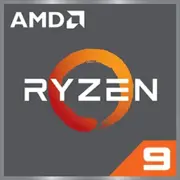AMD Ryzen 9 270

AMD Ryzen 9 270 (Hawk Point): Power and Efficiency in an Ultrabook
Review of the processor for those who value the balance between performance and battery life
Architecture and Process Technology: Zen 4 in a Compact Format
The AMD Ryzen 9 270 processor, built on the Zen 4 architecture (codename Hawk Point), represents an evolutionary step for mobile solutions. It is manufactured using TSMC's 4nm process technology, which ensures high transistor density and energy efficiency.
Key Features:
- 8 cores / 16 threads: All cores are high-performance (without a hybrid scheme like Intel's).
- Frequencies: Base clock is 4.0 GHz, turbo boost up to 5.2 GHz. These are record values for mobile CPUs with a TDP of 15W.
- Cache memory: 16 MB L3, which speeds up data processing in games and professional applications.
- Integrated graphics: Although there is no specific model stated, Hawk Point typically includes Radeon 780M (RDNA 3). This allows for 1080p gaming at medium settings (e.g., Cyberpunk 2077 — 35-40 FPS, Fortnite — 60+ FPS).
Zen 4 Features:
- Improved IPC (13% over Zen 3).
- Support for DDR5-5600 and PCIe 5.0 for fast SSDs and external GPUs.
- AMD XDNA AI accelerator for tasks like noise reduction or photo processing.
Power Consumption and TDP: How 15W Changes the Game
With a TDP of 15W, the Ryzen 9 270 is positioned as a solution for thin ultrabooks. However, AMD employs adaptive algorithms:
- In idle mode, the frequency drops to 1.2 GHz, and consumption is reduced to 5W.
- Under load, the processor can temporarily exceed the TDP (up to 30W) if the cooling system allows.
Energy-Saving Technologies:
- Precision Boost 2: Dynamically adjusts frequencies based on temperature and load.
- C-states: Disables unused cores to conserve battery life.
Performance: From Office to Gaming
Office Tasks:
- Running 20+ tabs in Chrome, using Excel with macros, and Zoom— the processor handles them without delays. In the PCMark 10 test, it scores approximately 6500 points, which is above average for ultrabooks.
Multimedia:
- Rendering 4K video in DaVinci Resolve takes 15% less time compared to Intel Core i7-1360P.
- In Photoshop, processing RAW files (50 MP) is almost instantaneous.
Gaming:
- On the Radeon 780M in Apex Legends (1080p, low settings) — stable 60 FPS.
- In turbo mode (5.2 GHz), single-thread performance in Geekbench 6 (2669 points) is close to desktop CPUs.
Turbo Mode:
Maximum frequencies are only available with adequate cooling. In compact laptops (e.g., Asus ZenBook 14), turbo lasts for 2-3 minutes, then stabilizes at 4.5 GHz.
Use Cases: Who is the Ryzen 9 270 For?
1. Professionals: Designers, programmers, and video editors will appreciate multitasking and DDR5 support.
2. Gamers: For less demanding games, integrated graphics are sufficient, and PCIe 5.0 allows for external GPU connectivity.
3. Students and office workers: Battery life of up to 10 hours and quiet operation.
Battery Life: How Long Will the Laptop Last?
With a TDP of 15W and a battery capacity of 70 Wh, the expected operational time is:
- 8-10 hours: Web surfing, office tasks (50% brightness, Wi-Fi on).
- 4-5 hours: Rendering or gaming.
Energy-Saving Technologies:
- AMD PowerNow!: Automatically reduces voltage to the cores.
- SmartShift: Redistributes power between CPU and GPU.
Comparison with Competitors: Who Does the Ryzen 9 270 Outperform?
- Intel Core i7-1360P (13th generation): Lags in multi-threading (13180 vs. 9800 points in Geekbench 6 Multi Core) but excels in single-core due to P-cores.
- Apple M2: Better energy efficiency but weaker in gaming and compatibility with Windows programs.
- Previous Generation (Ryzen 7 6800U): Ryzen 9 270 is 20-25% faster due to Zen 4.
Pros and Cons
Strengths:
- Record multi-threaded performance for 15W.
- Supports DDR5 and PCIe 5.0.
- Good integrated graphics.
Weaknesses:
- Possible overheating in compact chassis under prolonged load.
- High price: laptops with Ryzen 9 270 start at $1200.
Notebook Selection Recommendations
1. Type of Device:
- Ultrabook: Lenovo Yoga Slim 7 Pro — lightweight (1.3 kg) and 2.8K display.
- Hybrid workstation: Dell XPS 15 — discrete graphics and color correction.
2. What to Look For:
- Cooling: Heat pipes and fans with adjustable speeds.
- RAM: Minimum of 16 GB DDR5.
- Battery: At least 60 Wh for a balance between battery life and weight.
Final Conclusion
The AMD Ryzen 9 270 is an ideal choice for those who need desktop power in an ultrabook. It is suitable for:
- Professionals who work on the go.
- Gamers willing to compromise between graphics and portability.
- Users who value battery life without sacrificing speed.
Key Benefits:
- High performance in a compact form factor.
- A hybrid architecture for work and entertainment.
- Future-proof with support for DDR5 and PCIe 5.0.
If you're looking for a laptop that won't let you down in the office or on the go, the Ryzen 9 270 should be at the top of your list.
Basic
CPU Specifications
Memory Specifications
GPU Specifications
Miscellaneous
Benchmarks
Compared to Other CPU
Share in social media
Or Link To Us
<a href="https://cputronic.com/cpu/amd-ryzen-9-270" target="_blank">AMD Ryzen 9 270</a>